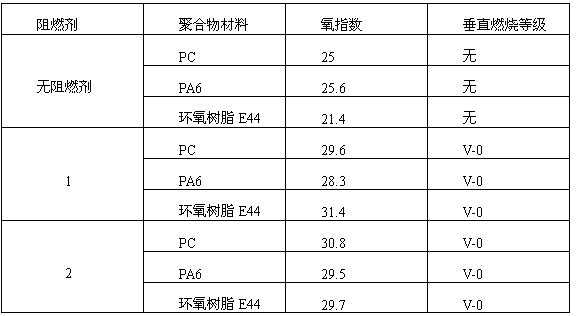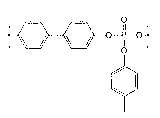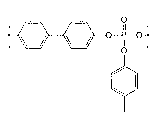Biphenol polyphosphate fire retardant and preparation method and application thereof
The technology of biphenyl diphenol polyphosphate and tolyl dichlorophosphate is applied in the field of polymer type phosphorus-containing flame retardant and its preparation, and can solve the problem of flame retardant exuding flame retardant performance, decline, use and storage. and inconvenient transportation to achieve the effect of good flame retardant effect, wide application range and excellent durability
- Summary
- Abstract
- Description
- Claims
- Application Information
AI Technical Summary
Problems solved by technology
Method used
Image
Examples
Embodiment 1
[0022] Put 186g of biphenol and 1.33g of aluminum chloride into a four-necked flask equipped with a condenser, a stirrer, a thermometer and a protective gas inlet and outlet, pass in nitrogen, stir and raise the temperature to 60°C, and drop gradually within half an hour Add 225 grams of p-cresyl dichlorophosphate, keep the temperature for reaction for 4 hours, then raise the temperature to 200°C and react for 3 hours until no HCl gas escapes (reaction ends). After cooling, 300ml of chloroform was added to dissolve it completely, and then poured into 8 times the volume of anhydrous methanol for precipitation. After filtration and vacuum drying, 320g of white powdery solid was obtained, with a yield of 94%. The weight average molecular weight of the obtained flame retardant was 29045 through gel chromatography detection.
Embodiment 2
[0024] Put 167.4g of biphenyldiphenol and 2.72g of zinc chloride into a four-necked flask equipped with a condenser, a stirrer, a thermometer and a protective gas inlet and outlet, feed in nitrogen, stir and raise the temperature to 70°C, gradually within half an hour Add 314 g of p-cresyl dibromophosphate dropwise, keep the temperature for reaction for 4 hours, then raise the temperature to 200° C. and react for 4 hours until no HBr gas escapes (reaction ends). After cooling, 300ml of tetrahydrofuran was added to dissolve it completely, and then poured into 10 times the volume of deionized water for precipitation. After filtration and vacuum drying, 278g of white powdery solid was obtained, with a yield of 91%. The weight-average molecular weight of the obtained flame retardant was 26322 as detected by gel chromatography.
Embodiment 3
[0026] Put 205g of biphenyldiphenol and 2.19g of calcium chloride into a four-necked flask equipped with a condenser, agitator, a thermometer and a protective gas inlet and outlet, pass in nitrogen, stir and raise the temperature to 60°C, and drop gradually within half an hour Add 225 grams of p-cresyl dichlorophosphate, keep the temperature for reaction for 1 hour, then raise the temperature to 200°C for reaction for 4 hours, until no HCl gas escapes (reaction ends). After cooling, 300ml of dimethyl sulfoxide was added to dissolve it completely, and then poured into 8 times the volume of anhydrous methanol for precipitation. After filtration and vacuum drying, 307g of white powdery solid was obtained, with a yield of 90%. The weight-average molecular weight of the obtained flame retardant was 26015 through gel chromatography detection.
PUM
 Login to View More
Login to View More Abstract
Description
Claims
Application Information
 Login to View More
Login to View More - R&D
- Intellectual Property
- Life Sciences
- Materials
- Tech Scout
- Unparalleled Data Quality
- Higher Quality Content
- 60% Fewer Hallucinations
Browse by: Latest US Patents, China's latest patents, Technical Efficacy Thesaurus, Application Domain, Technology Topic, Popular Technical Reports.
© 2025 PatSnap. All rights reserved.Legal|Privacy policy|Modern Slavery Act Transparency Statement|Sitemap|About US| Contact US: help@patsnap.com



